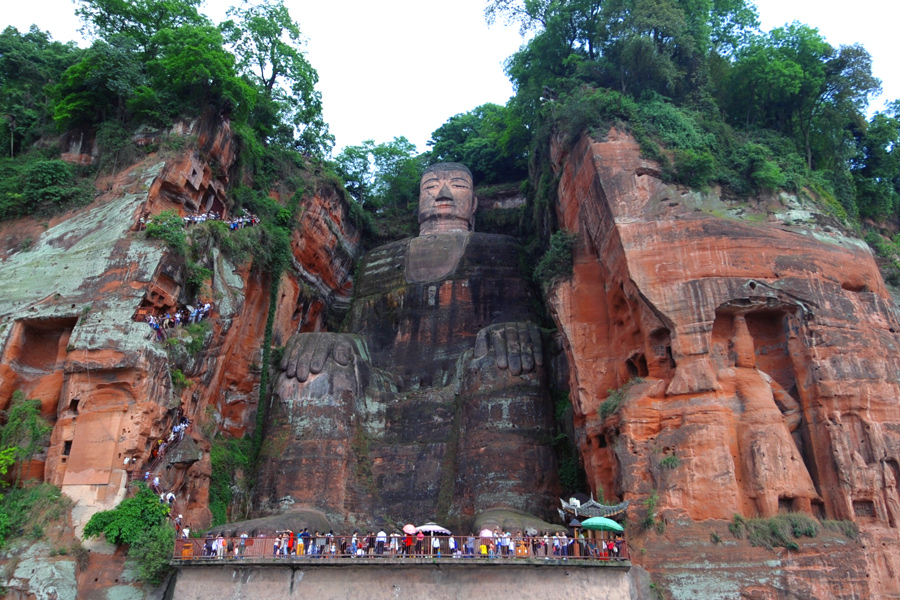 |
|
[Photo/Xinhua] |
Category of site: Mixed site
Brief introduction
Located on the western rim of the Sichuan Basin, in Southwest China's Sichuan province, Emei Mountain is one of the four scared Buddhist mountains of China.
There are a number of threatened species, some being endemic to Emei Mountain. Atop the Golden Summit, which is 3,077m high, one can enjoy the sunrise, seas of clouds, the “Buddha’s halo” and the sunset glow. Emei Mountain’s history has been recorded for over 2,000 years, during which time a rich Buddhist cultural heritage has accumulated.
The Leshan Giant Buddha scenic area, which covers 2.5 sq. km, is famous for its Giant Buddha statue, said to be the biggest Buddha statue in the world. The way in which the cultural features have been integrated with the natural scenery is considered to be a precious legacy. The Giant Buddha statue, carved on the mountain, stands 71m high, with its back against Mount Jiuding and facing the confluence of the Minjiang River, Dadu and Qingyi rivers. There are more than 90 stone carvings and Buddhist shrines on both sides of the Giant Buddha.
It was made a UNESCO World Natural Heritage Site in 1996.
Natural heritage
Emei Mountain is blessed with a world-acclaimed natural heritage. Below are details of selected items of the landscape, geomorphic features, vegetation and fauna. The site contains a diverse natural environment. Along the 60 kilometers-long trail up to the mountain there are hundreds of natural scenic spots, for example, the Palaces in Clouds, Sunrise on the Golden Summit, Surging Spring and Leshan Giant Buddha. The world’s highest stone statue of Maitreya is carved on Mount Lingyun, facing the Dadu River. Viewed from a distance, the mountain is in the figure of a Buddha while the Giant Buddha also looks like a mountain. The cultural heritage is in perfect harmony with the natural landscape.
The most varied topography of Emei Mountain includes a range of landscapes featuring high peaks and deep gullies. These landscapes are a direct result of the special geological structure of Emei Mountain. The majority of the late Precambrian sedimentary strata are well developed. The Emei Mountain basalt of late the Permian is of particular stratigraphic significance.
Cultural heritage
With large number of cultural and historic relics, Emei Mountain and the Leshan Giant Buddha scenic area contain a rich historic and monumental legacy. They are a common heritage of mankind.
On Emei Mountain, there are over 30 temples, 10 of them large and very old; they are in local traditional style and most are built on hillsides, taking advantage of the terrain. In the selection of the site, design, and construction they are masterpieces of great originality and ingenuity. The advanced architectural and building techniques are the quintessence of Chinese temple architecture.
Associated with these temples are some of the most important cultural treasures of China, including the remarkable Leshan Giant Buddha, carved in the 8th century out of the hillside of Xijuo Peak. Facing the confluence of the Minjiang, Dadu and Qingyi rivers, it is the tallest Buddha sculpture in the world at 71 meters.
Buddha’s halo and Holy lights
Buddha’s halo
This is a special physical phenomenon. When the sun projects the shadow of the viewer on the clouds in front of him or her, ice crystals and tiny drops of water in the clouds may reflect the light to form a rainbow around the shadow. Only in few places with the appropriate synchronization of light, landform and clouds can the halo be enjoyed.
Holy lights
On evenings when the moon cannot be observed (either in the early or late period of a lunar month), and after rain, tourists may see countless shining balls of light rising from the foot of the cliff and floating up in the air. This is the mysterious scene of holy lights.